|
| Many people are contacting me about the untended growth of grass and weeds in street medians and along the edges of major streets.
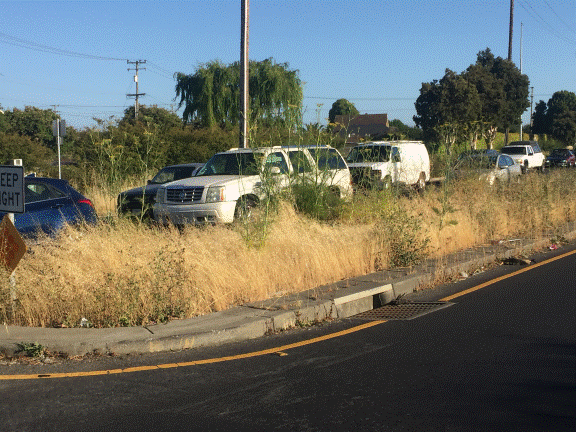
Richmond’s Department of Infrastructure and Operations is equally frustrated about this. After four years of severe drought, record-breaking rainfall last winter resulted in record-breaking plant growth, that has simply overwhelmed the City’s limited resources.
Tim Higares has been in charge of the Parks and Landscaping Division for only a little over a year; and he can firmly attest to the fact that keeping our city free of weeds is one of his most daunting challenges. We currently have 36 budgeted positions in the Parks and Landscaping Division. Of these positions, only six are assigned strictly to the General Fund areas. The rest of the staff is allocated to the five person tree crew and the Hilltop and Marina Special Districts where their services are paid for by property owners rather than from the general fund. The General Fund area includes approximately 46 parks and related infrastructure, 15 public building grounds and 23 pedestrian and bicycle pathways. There are also many “Very High Fire Severity Zones” that must be abated by hand and numerous medians, and planter strips that require continuous attention throughout the City. This staff of six must also maintain broken irrigation, fix or replace broken playground equipment, aerate and fertilize the fields and ball parks, and prepare and staff the many weekend city special events and functions.
Although an increase in staffing would clearly make a difference, there is simply no source of funds to make that possible. We have to make do with what we have and work smarter to get ahead of Mother Nature.
One solution we are exploring is creating additional landscape maintenance districts where property owners taxed to pay for a higher level of maintenance districts. This is what we have now at Hilltop and Marina Bay.
Currently, we already have or are in the process of implementing the following:
- Deploying Abatement, Facilities, grant funded and Maintenance Aides to do landscape work throughout the City;
- Adding several more Maintenance Aides (4/6) to the team in July;
- In discussions with Chevron to reinvigorate the Chevron Volunteer program;
- Promoting a Supervisor to a Senior Parks Supervisor to provide operational guidance, oversight and to help prioritize and direct the daily work flow. This will be a workingSupervisor that will be promoted from within;
- Approving overtime to focus on median and Very High Fire Zone abatement;
- Reorganizing the General Fund Crew and assigned areas;
- Looking for ways to incorporate Marina and Hilltop crews into some of the General Fund Areas;
- Working with Police to resolve the homeless encampments and vandalism to our park restrooms;
- Continuously seeking volunteers to work with us to maintain our parks and greenway;
- Working with Police to explore the possibility of expanding the Park Ranger duties to include locking bathrooms and minor park maintenance;
It is important to note that we do have a set maintenance schedule that staff diligently tries to follow. However, some of the operational realities that impact our ability to consistently follow these schedules consistently;
- Daily “emergency calls”
- Ongoing vandalism issues; this has increased exponentially:
- Inability to deploy Marina and Hilltop into the General Fund areas;
- Injuries, sick leave, scheduled vacation and emergencies factor in to the ability to keep to a schedule with such a small team;
Following is a Maintenance Schedule for Parks and Facilities.
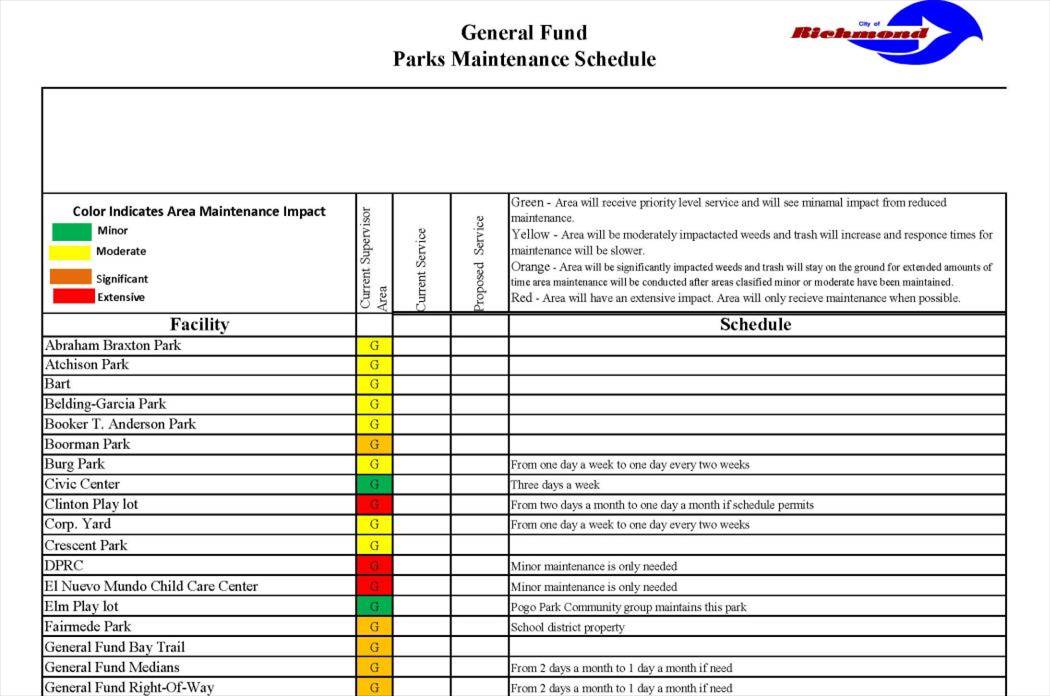
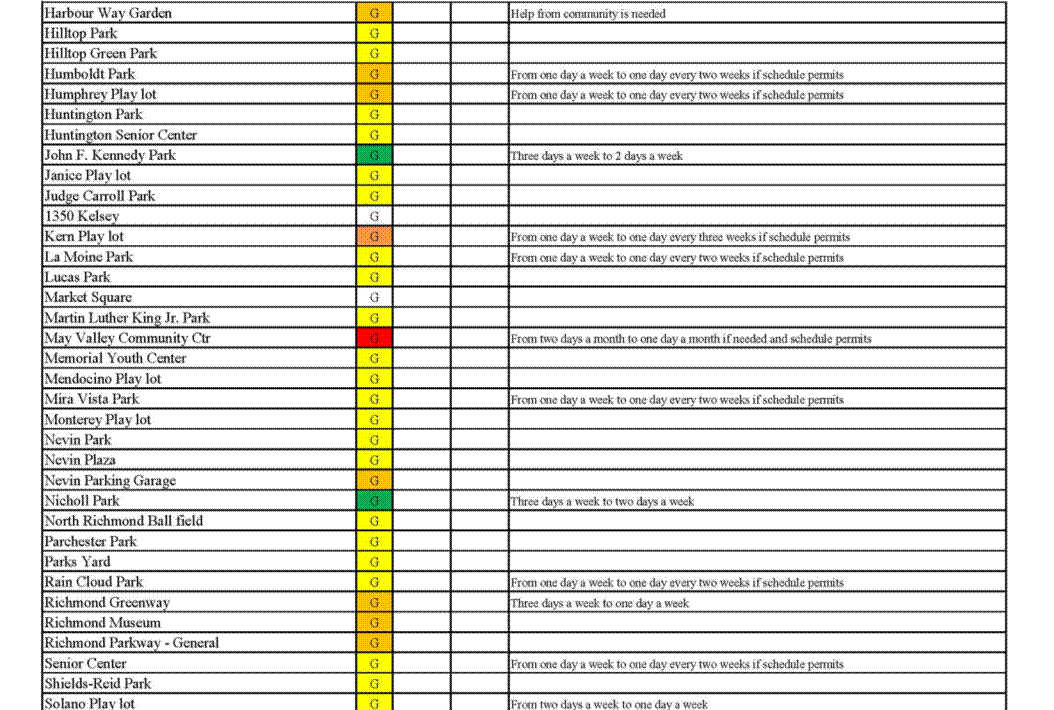
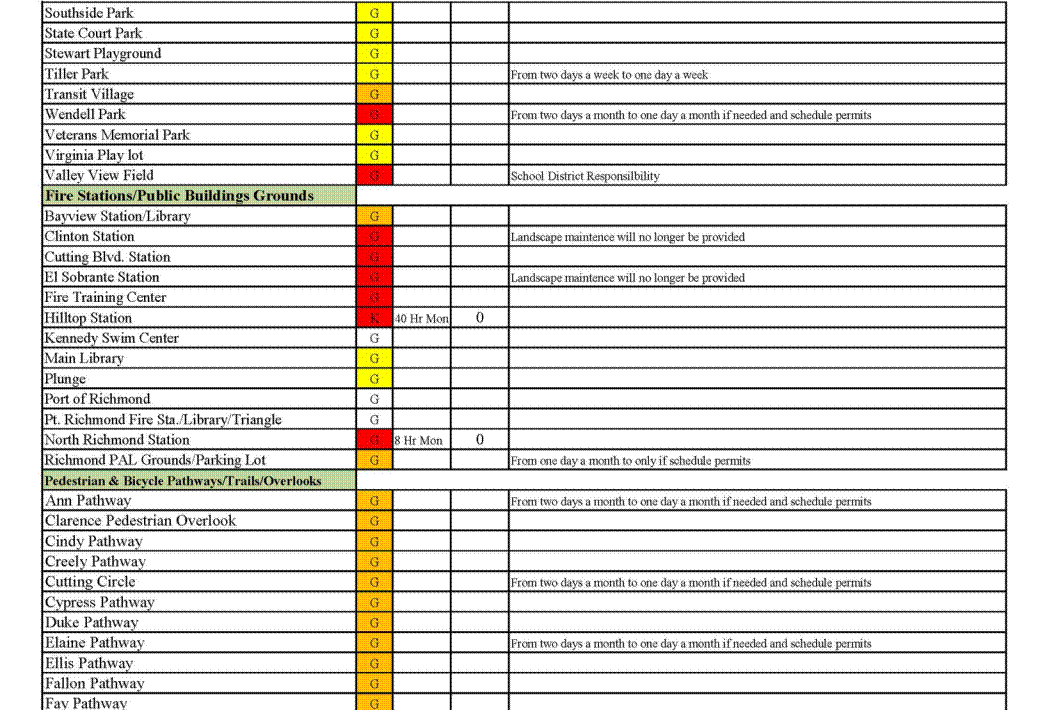
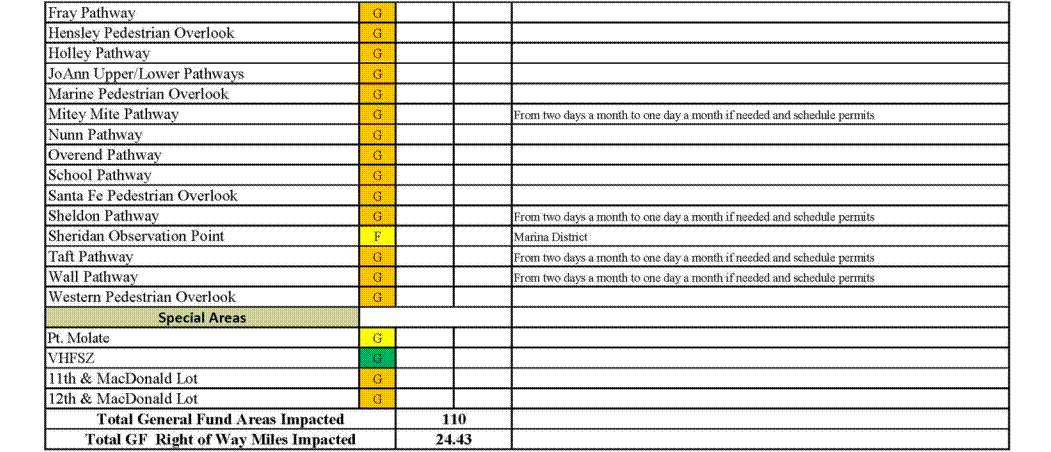
Following is a general schedule of activities of the Public Works Department Parks and Landscaping Division:
City of Richmond
Preventative Maintenance Program
Public Works Department
Parks and Landscaping Division
January
- Check ground drains and v-ditches for debris blockage and clear as needed.
- Begin grass and weed height control in non-irrigated and open space areas (as in the VHFHSZs).
- Check for vertebrate pest activity.
- Continue dormant care.
- Start irrigation coverage checks and flush systems as required.
- Finish wild flower seeding.
- Continue leaf litter and debris removal in all areas as needed.
- Trim trees as needed and after storms.
- Check for and clean or paint over graffiti.
- Check plantings located under eves of building or in court yards which may not be getting enough rain water and provide irrigation as needed.
- Perform special shop projects as needed during heavy rains.
- Inventory fertilizers and other materials and place orders as needed in preparation for the coming growing seasons.
February
- Mow high stands of ground cover such as Hedera, Ceratostigma, and Hypericum.
- Continue irrigation coverage checks.
- Update irrigation schedule charts as needed. Note any changes into as-built plans. Change out old back-up batteries in controllers as needed.
- Make any extensive irrigation repairs discovered.
- Continue grass and weed height control (VHFHSZs, etc.).
- Begin spring time pre-emergent weed control.
- Finish dormant care of shrubs, vines, and trees.
- Fertilizer applications as needed for all sites.
- Provide dormant pruning of trees, shrubs, and vines.
- Continue leaf litter and debris removal in all areas as needed.
- Start moderate lawn mowing and edging program.
- Confirm that all lawn mowing and edging equipment are available, serviced and ready to go. Be sure all blades are available and edged.
- Perform special shop projects as needed during heavy rains.
March
- Check ground drains and v-ditches for debris blockage.
- Prune vegetation for line of site obstruction at street intersections.
- Continue spring time pre-emergent weed control.
- Establish springtime watering program.
- Finish irrigation coverage checks and any extensive repairs.
- Continue grass and weed height control (VHFHSZs, etc.).
- Finish application of fertilizers in ground cover areas and start lawn fertilizer program.
- Continue dormant pruning of trees, shrubs and vines.
- Start full lawn mowing and edging program. Mow according to park and grass type as well as use and weather conditions.
- Trim trees as needed and after storms.
- Check special field placed equipment (like pumps, aerators, filters, booster pumps, etc.) for proper operation and make adjustments or order repairs as needed.
April
- Check for aphid and other infestations in shrubs, ground covers, and trees.
- Finish spring time pre-emergent.
- Remove stakes and ties from maturating tees where they are no longer needed.
- Mow 10’ wide zone at non-irrigated verges along the edge of roadways.
- Clear weeds from all tree basins and break (cut only if needed) out suckers.
- Continue weed abatement in VHFHSZs.
- Continue lawn mowing and edging. Mow according to park and grass type as well as use and weather conditions.
- Replace backup batteries (where needed) in irrigation controllers.
- Trim trees as needed.
- Dress ballfields as needed.
- Remove erosion controls from new projects as needed.
- Check basin walls of new plantings and adjust as needed.
May
- Fertilizer applications as needed.
- Complete grass and weed height control in VHFHSZs and set inspections with Fire Prevention.
- Edge control vegetation along medians, streets, sidewalks, and retaining walls.
- Prune vegetation for line of sight obstruction at street intersections.
- Begin flushing program on all drip systems.
- Continue leaf litter and debris removal in all areas as needed.
- Continue lawn mowing and edging. Mow according to park and grass type as well as use and weather conditions.
- Check and clean or repair remote control valves as needed.
- Trim trees as needed and check conifers for tipping back.
June
- Clean and adjust irrigation heads throughout summer.
- Repair irrigation breaks as they are detected.
- Prune vegetation for line of sight obstruction at street intersections.
- Flush drip systems.
- Complete weed abatement of VHFHSZs following inspections.
- Continue lawn mowing and edging. Mow according to park and grass type as well as use and weather conditions.
- Trim trees as needed and check palms for lifting spent fronds.
- Check for and clean or paint over graffiti.
July
- Check drip irrigation system for proper function.
- Flush and clean irrigation filters.
- Trim ground covers away from buildings, fences, trees and other features.
- Prune for line of sight obstruction at street intersections.
- Check young trees for deep watering.
- Supply manual irrigation where needed to prevent leaf drop or stress.
- Adjust watering times on controllers for hot summer periods.
- Flush drip systems.
- Plan for clearing of surface drainage systems leading up to start of rainy season.
- Continue leaf litter and debris removal in all areas as needed.
- Continue lawn mowing and edging. Mow according to park and grass type as well as use and weather conditions.
August
- Cut out spent blossom spikes (head back) on perennial plants and shrubs, such as Agapanthus, Echium, Moraea, Hemerocallis and Roses.
- Adjust irrigation to avoid wet spots and watering non-landscape areas.
- Check and clean remote control valves as needed.
- Edge and control vegetation along medians, streets, sidewalks and retaining walls.
- Adjust irrigation watering times for dark hours.
- Prune vegetation for line of sight obstruction at street intersections.
- Flush drip systems.
- Clear all ditches, channels and surface drainage structures.
- Continue lawn mowing and edging. Mow according to park and grass type as well as use and weather conditions.
- Trim trees as needed.
September
- Start to trim “sail” out of fast growing evergreen trees.
- Prune vegetation for line of sight obstruction at street intersections.
- Start checking tree stakes and ties and adjust as needed.
- Begin fall pre-emergence weed control.
- Trim “sucker” and “water shoots” off of trees.
- Clean and paint utility boxes and other furnishings and structures as needed before rainy season starts.
- Repair pathways as needed and spray with an approved binder before rainy season starts.
- Walk all v-ditches and compact soil along edges to prevent water access beneath v-ditch and lips of catch basins. Place rip rap stones at infalls and outfalls as needed. Order more extensive repairs as needed.
- Prepare plant lists and place orders to start plantings in fall and winter months.
- Clear all ditches, channels and surface drainage structures.
- Continue lawn mowing and edging. Mow according to park and grass type as well as use and weather conditions.
- Check for and clean or paint over graffiti.
- Inventory and order as needed necessary tools, apparel and materials for the rainy season (including what may be anticipated for indoor rainy day shop projects).
October
- Continue trimming “sail” in fast growing trees.
- Continue to check tree stakes and ties.
- Continue fall pre-emergence weed control.
- Start “rolling back” watering times on controllers.
- Appropriately trim shrubs and edge ground covers so as to maintain desired shape through winter months.
- Provide aggressive leaf litter and plant debris removal along gutters, landscape frontages, medians, sidewalks, planter beds, and beneath plant canopies. This is a weekly task to be carried throughout the fall and winter months.
- Continue lawn mowing and edging. Mow according to park and grass type as well as use and weather conditions.
- Apply final adjusted lawn fertilizers.
- Trim trees as needed.
- Apply erosion controls as needed in new project sites.
- Check basin walls around new plantings and adjust as needed.
- Check trash cans and lids as well as other park furnishing and signage and refit, repaint or replace as needed or assign to a winter (rainy season) shop project.
- Inventory all capital equipment and confirm depreciation status or replacement needs. Confirm all auxiliary material needs for equipment (replacement blades, etc.) and place orders as needed. Commit selected equipment to servicing.
- Start refurbishment of sports fields during scheduled rest periods.
November
- Start planting wildflower seeds.
- Check edges of culverts, drainage ditches and catch basins for erosion of soil.
- Establish low demand winter watering program (but keep periodic syringe cycles programmed).
- Check all sites for damage after storms throughout winter months.
- Edge and control vegetation along medians, streets, sidewalks, and retaining walls.
- Complete pre-emergence weed control.
- Dormant care of some shrubs, vines and trees.
- Continue leaf litter and debris removal in all areas as needed.
- Take lawn mowing and edging down to an as needed level.
- Turn selected lawn mowing and edging equipment in for comprehensive services or replacements as needed.
- Trim trees as needed and after storms.
- Check for and clean or paint over graffiti.
- Check for delicate plants that may be exposed to very cold conditions through the winter and apply anti-transparent as needed.
- Plan and perform any special cleanups for the holidays and confirm availability of staffing.
- Confirm new staffing and equipment needs for budget preparation.
- Perform special shop projects during heavy rains.
December
- Continue planting wildflower seeds.
- Continue dormant spraying as needed.
- Trim ornamental berry shrubs and trees.
- Start preparing plans for weed control in the Very High Fire Hazard Severity Zones (VHFHSZs) and other open spaces areas.
- Continue leaf litter and debris removal in all areas as needed.
- Trim trees as needed and after storms.
- Check for and clean or paint over graffiti.
- Check plantings under eves of buildings and in court yards which may not be getting enough rain water and provide water as needed.
- Perform special shop projects during heavy rain.
|
|

